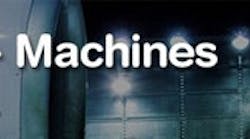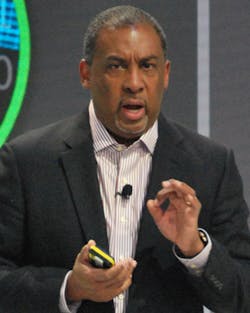Everyone knows about those evil twins who do bad things behind our backs, but what if you had a good, even angelic better self that worked tirelessly to improve your awareness and performance? Pretty sweet, right?
Well, that's exactly what GE's Digital Twin program, staff, support software and other tools do for GE's customers and their businesses. Several of these appreciative beneficiaries showed up this week at the Minds + Machines 2015 conference in San Francisco to describe their experiences in a session entitled "Digital Twin: The Mind of the Machine."
From consumer to industry
"Basically, we're looking at technical advances on the consumer side that we can use on the industrial side," said Colin Parris, vice president, software research, at GE Global Research. "For instance, Amazon has grown over 21 years to reach $89 billion in revenue in 2014, and though it started out selling books, it's also learned how and when its customers decide to buy, formed psychographic models of them, and maximized its selling efficiency. This gets Amazon to a profit-and-loss [P&L] statement for each of is customers. The question we're asking is: How can we do this for industry?
"We create per-asset engineering models, use these models to continuously tune and increase insights, and delivers specific business outcomes for each asset—an industrial P&L of one." GE's Colin Parris on the company's Digital Twin methodology.
"GE and its customers have fleets of aircraft engines, trains and other equipment," Parris continued. "Our Digital Twin approach forms per-asset engineering models, uses these models to continuously tune and increase insights, and delivers specific business outcomes for each asset—an industrial P&L of one. This can take many costs off the table, and massively reduce service requirements at the same time. For example, to reduce the maintenance costs of a single blade on our GE 90 aircraft engine, we can use a blade-spallation, cumulative-damage model in Digital Twin that's updated per flight, and this can save millions of dollars in unnecessary service event calls per customer.
"In addition, just as Amazon's customers write product reviews that draw in other customers, machines can attract other machines, too. Then, when a wind turbine is trying to adjust its blade pitch for maximum effectiveness, it can ask other wind turbines, and employ useful data from them. This is how Digital Twin can create a cloud-based ecosystem of sharing and dynamic teams of machines."
Parris added that Digital Twin's key enabling technologies include:
- Domain data, which is automated information for preprocessing;
- Physics and data-based engineering models built from cumulative wear and damage reports, microstructure-based lifting, dynamic performance estimates and other sources;
- Industrial analytics based on model generation, automation and knowledge extraction; and,
- GE's Predix platform, which organizes and oversees all the other sections, and makes Digital Twins and other information available to users.
Customer know-how
Just as users of consumer devices create apps, GE's customers are driving development of Digital Twin solutions.
Frank Carbone, assistant vice president at CSX, reported that the railroad has 21,000 miles of routes in 23 states, runs 1,500 trains per day, and has 4,000 locomotives that transport more than 6.5 million carloads per year. "We've reduced greenhouse gas [GHG] emissions by 8% prior to 2010, and we're on track to cut GHGs another 6-8% by 2020," explained Carbone. "We're using GE's Trip Optimizer software and other tools on 1,500 locomotives to help achieve these gains. So far, Trip Optimizer has reduced CSX's GHG emissions by 174,000 tons, and saved 11.8 million gallons of fuel."
Justin Arkin, senior sales manager at GE Transportation, added, "Trip Optimizer can make decisions for every type of train traffic and terrain, improve fuel savings and safety, and also give operators more situational awareness. Human operators can mostly only plan for immediate situations, and so they apply brakes in areas where trains have to run slower. Trip Optimizer is a Digital Twin that includes data on grade, traffic, weather and other factors, and then makes a plan to use a train's kinetic energy more efficiently, and continuously adapts it so the train doesn't need to use its brakes as much."
Clear-eyed maintenance
Similarly, Mohamed Ali, general manager for services performance and analytics in GE Aviation's services engineering division, reported that condition-based maintenance began about 20 years ago, and is evolving to become more based on analytics, which drives more predictive maintenance practices.
"We're doing physics-based analytics because environmental conditions are a huge predictor of engine time on wing," said Ali. "But planes generate about 1 gigabyte of data per day, so we put it all into a Predix-based data link, and then use it to build our cumulative damage models [CDMs] and do Digital Twins per engine and per failure mode. We still do automated and boroscope inspections, and run deep-learning algorithms to see if we've matched our models, but then we can use this data to update our models to better reflect reality. All these analytics help reveal early indications of stresses earlier. Outliers emerge from the data in our single-component cumulative distress model, and we can show it, and check each device."
Likewise, Jayraj Nair, head of the Internet of Things (IoT) practice at Infosys, added that Digital Twins are ideal for critical equipment such as its landing gear systems, and improves business outcomes by avoiding downtime and optimizing costs. He cautioned, however, that the Digital Twins must be continuously updated to reflect the truth of current operating conditions. Infosys accomplishes this by using Predix's scalable, cloud-based infrastructure. "Our Digital Twin relies on 30-40 sensors on the landing gear, which sense tire pressure, drag, side and vertical loads, and brake temperature and pressure," said Nair. "Our Digital Twin predicts remaining useful life, and that makes a big difference."
Power and water assistance
Finally, Mark Hachenski, executive product manager at GE Power & Water, reported that his division's Digital Twin approach uses physics and digital fusion to drive asset performance. "We've always adapted old models, and added more performance data, but in the past, they weren't updated daily," said Hachenski. "Today, we're adding thermal, control and performance models all the time to optimize operations and increase value to our customers. Now, we can predict 45 minutes ahead of time when the operational performance of a plant is going to change, and the value created adds up to 13 megawatts saved, or about $2 million in revenue."
Clift Pompée, manager of information and analytics at Duke Energy, agreed that Digital Twins are helping its facilities see and respond to anomalies much sooner. "To get to the next level of equipment reliability in our turbine and energy services group, we need to understand our equipment and operations even more deeply," explained Pompée. "We already have historical data; the observations of subject matter experts; maintenance and diagnostic alerts; operations logs; and inspection, stoppage and outage reports. However, in the last few years, we've found events and conditions that continue to eat up some of the useful life of our machines. We've opened them up to understand even better how they age. We're just starting to partner with GE on our steam turbine fleet to add up failure modes, develop monitoring plans, mitigate these modes, optimize performance, and get closer to zero events."








